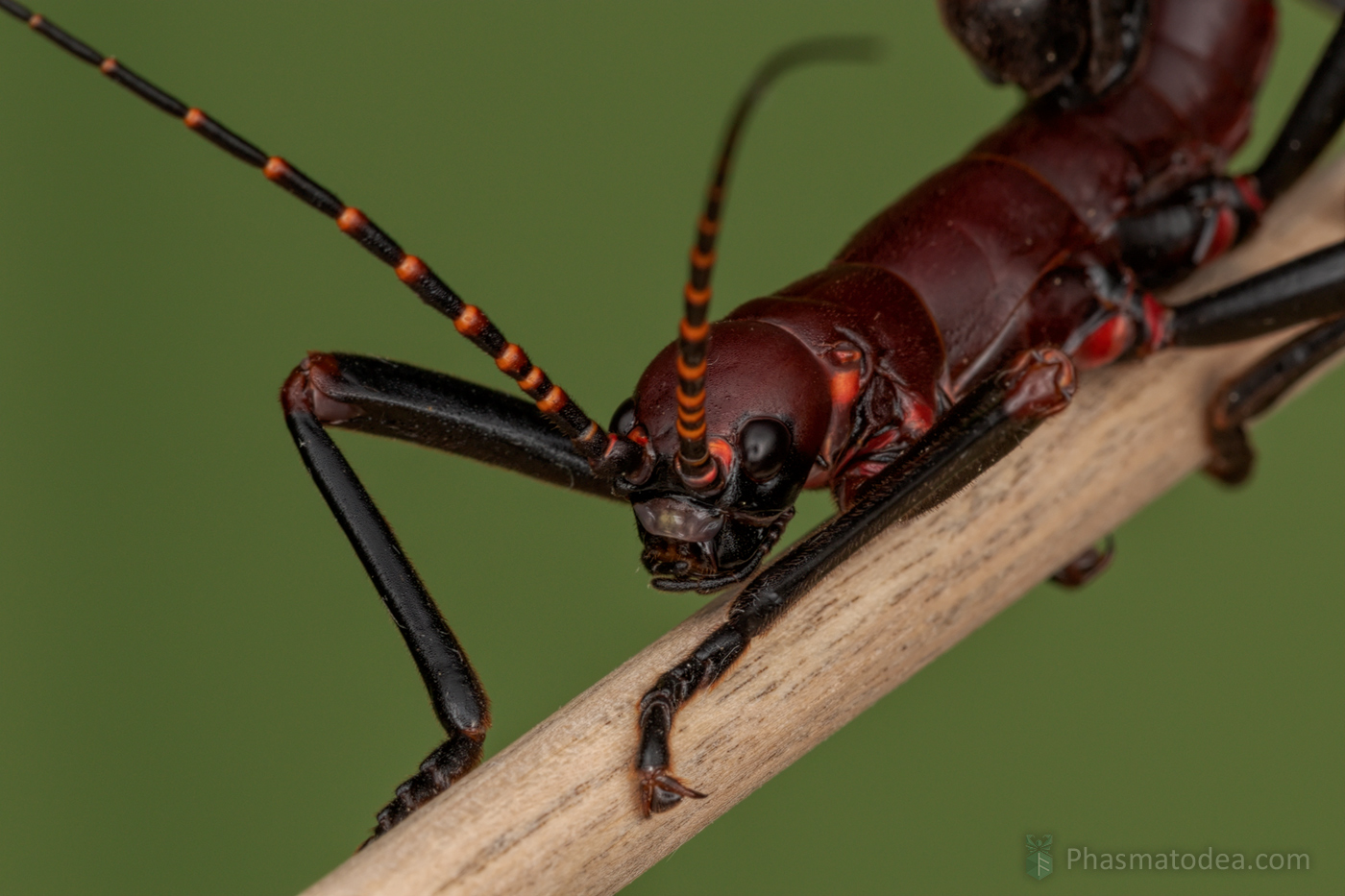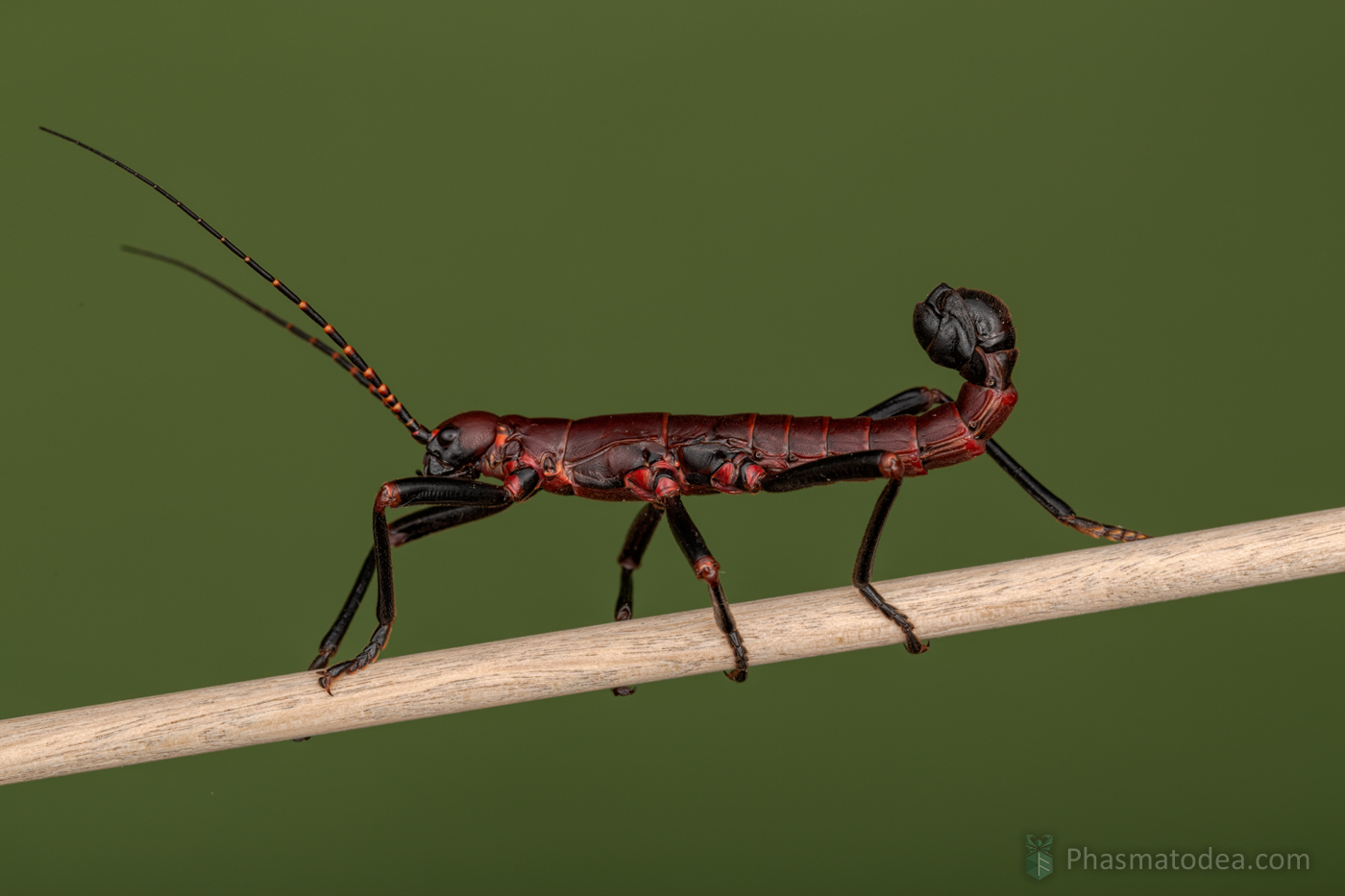
(by Bruno Kneubühler)
General Informations
- provenience: nothern suburb of Tegucigalpa (Honduras), between Tegucigalpa and Parque Nacional La Tigra
- locally called Chilincoco
- taxonomical evaluation by Oskar Conle (DE)
- further taxonomical informations ➤ Phasmida Species Files
Females
- beautifully colored small, stubby species
- body length ≈ 6 cm
- female's coloration is not variable across individuals (in F1 and in the wild)
- very pronounced black-red coloration
- unwinged
Males
- very similar to the females
- body length ≈ 5.5 cm
- male coloration is also very consistant across different individuals
- female's coloration is not variable across individuals (in F1 and in the wild)
- unwinged
Nymphs
- dark brown basic color, with whitish dots and bands
- body length ≈ 17mm
- general notes on how to distinguish between male and female nymphs, and in Autolyca herculeana "Tegucigalpa" nymphs
- when the nymphs grow up, they change their color gradually to the color of the adults. Subadult specimens already have the coloration of adults
Food Plants
- wild specimens have been observed to feed on a plant which seems to belong to Lantana
- privet (Ligustrum vulgare)
very well accepted by nymphs and adults - Salal (Gaultheria shallon)
well accepted by older nymphs and adults, not yet tested with freshly hatched nymphs - Osmanthus (quite a common and evergreen garden plant)
not yet tested, but other privet feeders also feed on this plant easily
Breeding, Behaviour
- easy to breed
- often also feeding during the day, but mainly night active
- they often try to escape and crawl away when they feel threatened
- they have a defensive spray, which is very pungent and reminds me of peppermint. Most probably this defensive spray irritates or even inflames (human) eyes and mucous membrans, so be careful when handling them
- adult males fight with eachother over the same female
- both males and females often vigorously tremble with their antennae, when they feel threatened
- it is difficult for nymphs and adults to climb plastic, thus glue plastic fly screen to at least two sides and the cage ceiling. This will help a lot that they have a safe grip
- especially smaller nymphs (and to some degree also older nymphs and adults) are very gregarious
- females need sand (or a similar substratum) to lay their eggs! They will dig a small, flat hole into the sand and then drop a whole clutch of eggs into that hole, while bending their abdomen over their head. Afterwards they try to cover up the hole with sand again, which is often not really successful
- here some videos how the females bury their eggs:
{"preview_thumbnail":"/sites/default/files/styles/video_embed_wysiwyg_preview/public/video_thumbnails/cR5C-dTjjyw.jpg?itok=_xOI82hu","video_url":"https://youtu.be/cR5C-dTjjyw","settings":{"responsive":1,"width":"854","height":"480","autoplay":0},"settings_summary":["Embedded Video (Responsive)."]}
{"preview_thumbnail":"/sites/default/files/styles/video_embed_wysiwyg_preview/public/video_thumbnails/qg1gT-7DmVk.jpg?itok=J8lI7n2m","video_url":"https://youtu.be/qg1gT-7DmVk","settings":{"responsive":1,"width":"854","height":"480","autoplay":0},"settings_summary":["Embedded Video (Responsive)."]}
{"preview_thumbnail":"/sites/default/files/styles/video_embed_wysiwyg_preview/public/video_thumbnails/JtGrTIP58UI.jpg?itok=toRXE-dY","video_url":"https://youtu.be/JtGrTIP58UI","settings":{"responsive":1,"width":"854","height":"480","autoplay":0},"settings_summary":["Embedded Video (Responsive)."]}
{"preview_thumbnail":"/sites/default/files/styles/video_embed_wysiwyg_preview/public/video_thumbnails/EW4g0bZLAwY.jpg?itok=qII2d4EK","video_url":"https://youtu.be/EW4g0bZLAwY","settings":{"responsive":1,"width":"854","height":"480","autoplay":0},"settings_summary":["Embedded Video (Responsive)."]}
- up to 15 eggs per clutch, about 1 clutch every 2 - 3 weeks
- incubation (Cup-Incubation-Method,on medium damp vermiculite) about 6 months at 20 - 24 °C (for F1)
- general note - it is quite common that, from the very same batch of phasmid eggs, some nymphs will hatch weeks or even months after the first nymphs
- eggs can be covered with vermiculite (about 5 mm high), which makes it easier for the nymphs to free themselves completely from the eggs shell
- eggs of this species are not particularely prone to get mouldy, still one can use spring tails to limit mould growth
- nymphs hatch during the night
- a humidity of about 70 % RH seems to be good enough for nymphs and adults
- do not spray this species, they don't like to be sprayed. If being sprayed then they become quite frantic
- small nymphs can be kept in a Faunabox (or a similar cage), which shall not be too small
- provide a cage of about 30 x 30 x 30 (cm, L x B x H) for 5 adult couples
- males will be adult after about 3 months (at 20 - 24°C), females after 3.5 months
- the male : female ratio in F1 was about 3 : 1
Some basics of phasmid breeding
- our detailed notes on how to successfully breed phasmids are an integral part of this care sheet
- keep just one species per cage. And in order to maintain strong and healthy cultures, often 2 -3 cages per species are needed (keeping nymphs and adults seperate). Informations on why and how to keep cultures seperate and pure
- whenever one posts informations or distributes a culture to fellow breeders, then make it a point to use the full and correct scientific name with provenience affix. Serious breeders do not use common names, as these only lead to confusion.
- correct is for example Extatosoma tiaratum "Innisfail" - for the pure culture from Innisfail
- incorrect is prickly stick insect for Extatosoma tiaratum
- if possible keep day temperatures below 28°C, and a nocturnal temperature drop is natural and advisable
- do not spray too often and nor too much, phasmids are no fish. In confined space of a cage, with it's very limited potential for climatic balancing, humidity and moisture can quickly become too much and give raise to excessive mould and microbiologial growth

















































